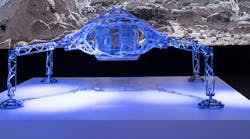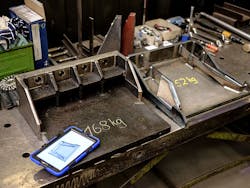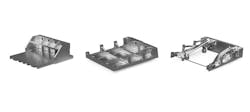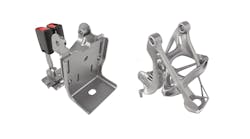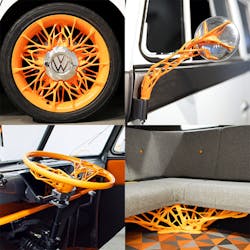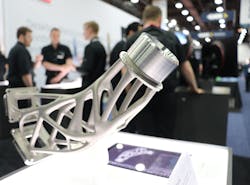We’re only a handful of months away from the year 2020, and with the way parts look and tech acts, it finally feels like we’re entering the future. It’s a future crafted by sophisticated 3D printers and machining centers, using materials provided by global-reaching supply chains and connected to an exponential rate of new superpowered gadgets. Nowadays, there’s really no reason to think any manufacturing feat is impossible. If something doesn’t exist, it’s just that we haven’t figured it out yet.
And this futuristic techtopia brimming with potential wouldn’t be possible if not for engineers—those dedicated, uber-creative folks plotting such a course, continuously improving the world around through the super power of… math.
Mathematics has been the indispensable fuel to make the impossible possible since at least the ancient Egyptians more than four thousand years ago. The Great Pyramid of Giza is the world’s oldest monument to its power. Amazingly, its geometrical elegance was calculated on papyrus scrolls, most of which have turned to dust long ago. Yet the universal language of math still speaks through its dimensions. And it will continue to do so for time immemorial.
Math doesn’t change, though there have been a fair number of improvements in how we access its truths. Calculating equations has evolved to become a lot easier and even paperless, with the heavy lifting done more on the digital side with CAD and CAM programs.
And since it really is the future, math, too, has received a supercharged upgrade in the last few years with availability of generative design software, now a standard feature of Autodesk’s Fusion 360. This method of designing parts and structures taps directly into the universe’s source code to create several permutations—from a few dozen to several hundred—in just a fraction of the time human brains would require. The engineering team can then decide what is objectively the perfect form factor for the application and customer.
Energized by machine learning and requiring basic inputs such as a material, manufacturing method, physical parameters and load values, a generative design program allows the user to land on the optimal design, just like their ancient Egyptian predecessors, though it’s doubtful it will look familiar. Unbound by previously prohibitive manufacturing restrictions thanks to 3D printing and machining advancements, these programs tend to spawn wildly unconventional parts that seem closer in relation to an H.R. Giger-inspired fever dream than a basic geometric shape. They also provide unimaginable cost and weight savings.
Alien Autopsy
Last year, Claudius Peters, a 113-year-old German industrial machine manufacturer serving the concrete, steel, gypsum and aluminum industries, discovered just how many benefits using Autodesk’s generative design software could yield. During a four-hour training session with Autodesk, their engineers iterated an improved version of the thick metal components they make that hold the molten cement pellets (or clinkers) as they are conveyed from the kiln to the ETA cooler. The machine is half the size of a football field, so there’s a need for 60 to 100 of these components, each weighing 370 lb.
The company had previously optimized the part design from a flat sturdy secretary desktop shape to one that resembles a jewelry box insert. The internally reengineered part weighed only 176 lb. and was made via casting. Not bad at all.
But then they ran the parameters through the Fusion 360 generative design software and found those improvements were still far from optimal. The system delivered a decidedly more skeletal structure, like something that fell off an antique typewriter. It also weighed 25% less than what was until then thought to be the “optimized” part.
Material Difference
The emergence of generative design could not have come at a better time, as the impetus for lighter parts has never been stronger. Cement production creates 8% of all CO2 emissions globally, so Claudius Peters’ effort to increase their energy efficiency makes a lot of sense. It makes even more sense for the transportation sector, which accounts for 15% of all greenhouse gases expelled annually. Lighter conventional cars expend less fuel while lighter electric vehicles have increased range. Generative design’s inherent lightweighting ability has naturally caught the attention of the automotive industry. Paired with additive manufacturing, the solution is slowly changing the way auto OEMs design and manufacture.
General Motors wants to be at the forefront of the EV movement, with 20 new models targeted by 2023. Using Autodesk’s generative design, they 3D-printed a stainless steel seatbelt bracket 40% stronger and 20% lighter than the original version, which comprised eight welded pieces.
All these examples were, of course, generatively designed, and aside from being excellent conversation starters, the parts, such as the alien rims, have a real purpose.
“The wheels are 18% lighter than the equivalent stock wheels would be,” project lead Paul Sohi, a Fusion 360 evangelist for Autodesk (and only person I know pursuing a doctorate in 3D printing). “And you know it's an electric vehicle, so every gram you save on that vehicle is an extra bit of range on the road.”
The bigger benefit to any engineer is the dramatic reduction in design lead time. For the wheels, Sohi says what once took 1.5 years dropped to four months. He says this allows the team to not only run more tests and simulations, but to also hasten “putting the wheels on the car and driving until they fall off.”
Andrew Morandi, senior product designer at Volkswagen, says that while this was VW’s way of dipping their toes in the futuristic design waters, he’s optimistic that this could be standard manufacturing practice in 10 to 15 years. “It’s possible this could be part of a complete, fundamental change in automotive factories and how cars are manufactured," he says.
Sohi admits that what the algorithms create is beautiful to the left side of the brain, where math and logic processing occurs, not the artsy right side.
“[Generative results] are engineered to perfection but that doesn't necessarily mean that they're going to be visually appealing,” Sohi says. “Those very organic forms of that generative design produces are very polarizing: Some people love them; some people hate them.”
Spatial Awareness
The Fusion 360 app is sometimes too good, and some post-processing is needed to smooth out little grooves the program put in to make the part even more efficient.
A Soho-based company founded in 2015, nTopology, offers a way to optimize the optimization with its nTop Platform.
“In nTop an engineer can automatically post-process the generated design into an editable format without time-consuming manual effort,” founder and CEO Bradley Rothenberg says. “This is actually true from inputs even from 3rd party generative or topology optimization programs that create a coarse tet mesh of the results. These can be imported into nTop to instantaneously convert into our native, editable format that is smooth.”
The 34-year-old Pratt Institute graduate is a huge advocate of the open platform model, allowing advanced engineers to tweak the rules on how their parts are generated.
“The entire process of crafting a workflow allows you to define your own algorithm that you have control over versus just twisting dials on a black box defined by a software vendor,” he says.
Rothenberg says his company has one simple mission: “To enable engineers to ship higher performing parts faster.”
And as smart as the A.I. becomes, it is still really a productivity tool.
“I don’t see us replacing engineers, but allowing them to focus more time on engineering,” Rothenberg says.
Because all those futuristic machining centers and additive machines can produce parts in days, not months, the bottleneck is at the design side. Rothenberg’s solution was to add more math, so he got into coding and came up with this optimization software, which also does a form of generative design.
And it ditches the old 2D drawing method relied upon since the first pyramid was being constructed. Even CAD programs would represent 3D shapes as layers, which Rothenberg thought was inefficient.
The model itself was hollow, and each surface would be a different equation, and where they intersect, errors may occur.
“This entirely new modeling technology which allows us to represent a 3D solid as an actual solid, evaluated parallel in the GPU and CPU, and it’s an order of magnitude in terms of speed to render, spatially around complex shapes,” he explains. “The whole shape is basically one big equation.”
Rothenberg also points to unlimited model complexity due to raytracing, and unparalleled reliability, saying nTop models “never fail or stall, no matter how many blends, rounds, fillets, booleans, offsets, etc. that they may have.”
The nTop platform has been used to design injection molding tooling with intricate interior cooling channels, medical devices and even a satellite bracket for Zenith Tecnica made with an Arcam electron beam melting (EBM) machine. Its weight was reduced by 60% using nTop.
